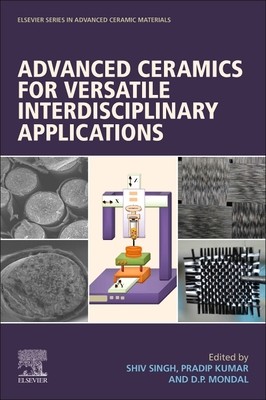
- We will send in 10–14 business days.
- Publisher: Elsevier
- ISBN-10: 0323899528
- ISBN-13: 9780323899529
- Format: 15.2 x 22.9 x 2.4 cm, softcover
- Language: English
- SAVE -10% with code: EXTRA
Advanced Ceramics for Versatile Interdisciplinary Applications (e-book) (used book) | bookbook.eu
Reviews
Description
Advanced Ceramics for Versatile Interdisciplinary Applications describes recent progress in ceramic synthesis and their applications in areas of catalysis, lithium-ion batteries, microbial fuel cells, and biomedical applications. Advancements in ceramic syntheses, such as laser additive manufacturing technologies are also discussed, as are developments in magnetic-based, doped and piezoelectric ceramics and their applications. Other sections cover mixed ionic-electronic conducting ceramic membranes for electrochemical applications, ceramic separators for microbial fuel cells, ceramic polymer composites for lithium-ion batteries, and hybrid ceramic nanocomposites for catalysis applications.
The use of metal and metal oxide nanostructures as antimicrobial agents offer a wide range of advantages, ranging from straightforward synthesis to less prone towards resistance development by microbes. Finally, the development of biocompatible ceramic materials, mechanical and chemical properties, and applications are discussed in detail. The book will be useful for new researchers, academics and postgraduate students all working in the area of ceramics and their potential applications.
EXTRA 10 % discount with code: EXTRA
The promotion ends in 14d.13:36:50
The discount code is valid when purchasing from 10 €. Discounts do not stack.
- Publisher: Elsevier
- ISBN-10: 0323899528
- ISBN-13: 9780323899529
- Format: 15.2 x 22.9 x 2.4 cm, softcover
- Language: English English
Advanced Ceramics for Versatile Interdisciplinary Applications describes recent progress in ceramic synthesis and their applications in areas of catalysis, lithium-ion batteries, microbial fuel cells, and biomedical applications. Advancements in ceramic syntheses, such as laser additive manufacturing technologies are also discussed, as are developments in magnetic-based, doped and piezoelectric ceramics and their applications. Other sections cover mixed ionic-electronic conducting ceramic membranes for electrochemical applications, ceramic separators for microbial fuel cells, ceramic polymer composites for lithium-ion batteries, and hybrid ceramic nanocomposites for catalysis applications.
The use of metal and metal oxide nanostructures as antimicrobial agents offer a wide range of advantages, ranging from straightforward synthesis to less prone towards resistance development by microbes. Finally, the development of biocompatible ceramic materials, mechanical and chemical properties, and applications are discussed in detail. The book will be useful for new researchers, academics and postgraduate students all working in the area of ceramics and their potential applications.


Reviews